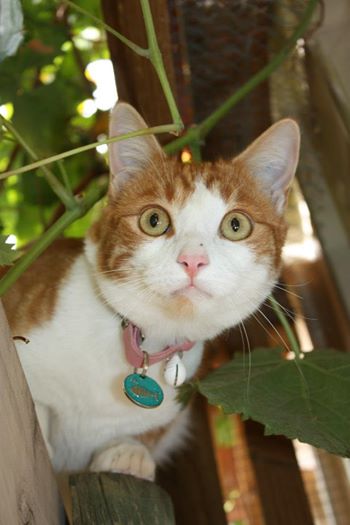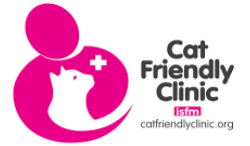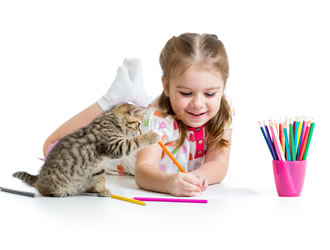Caring for your Pets
Cat Articles
Caring for your new Kitten
Environmental Enrichment for Cats
Feline Asthma
Feline Idiopathic Cystitis
Feline Immunodeficiency Virus
Food Puzzles for Cats
Happy Cat = Healthy Cat
Hyperthyroid Disease
Nursing care for your cat
Pain Medication for your Cat
Vaccinating your cat or kitten
Visiting the Vet with your Cat
Visiting Magill Village Vet with your Cat
A positive experience for both you and your cat
Visiting the vet can be a very stressful experience for both you and your cat.
We appreciate and understand this and it is our aim to make the experience as pleasant as possible for both you and your cat.
We want your cat’s visit to Magill Village Vet to be as pleasant as possible. The following information is provided to help you and your cat to have a more comfortable and relaxed experience.
Getting your Cat into the Carrier
Why must you put your cat into a carrier? The simple answer is safety: cats who are correctly secured in carriers cannot become projectiles should the car stop suddenly; they cannot become panicked and entangled in the pedals or steering wheel; they are protected from a panicky response that could cause them to run into traffic when the door opens; and they are able to be transported safely and quickly into our clinic.
The first step in using carriers is to make a carrier a comfortable, secure place for your cat.
Keep the carrier open in the house. Leave the carrier out all the time, or at least for several days before the appointment. Leave a blanket or towel in the carrier, as well as toys and treats.
Regularly throw treats or feed meals in the carrier. Some treats that most cats will try, even in stressful settings, include smears of Dine Creamy Treats or Vegemite, small pieces of bacon, anchovies, tinned tuna or sardines. Praise your cat for entering the carrier. Start coupling this sequence—carrier, tossed treat, cat in carrier, praise—with a word or phrase that he cat will learn means he is to go into the carrier (eg “travel time”). If your cat learns to like the carrier and to associate it with treats or meals, getting him to go in on cue is a very easy next step.
Feliway (a synthetic pheromone analog) is available at the clinic and may be helpful if you spray it in the carrier 5-10 minutes before you expect to have the cat use it. Feliway has a calming effect on most cats.
Bring favourite toys, treats or blankets to help comfort your cat in a strange environment.
If your cat loves to be combed or brushed, you can bring the comb or brush to use during the examination to help comfort your cat.
Never yell at or chase the cat to get him or her into the carrier. If your cat does not go into the carrier on cue, get your cat to come into a bathroom or another small room with you where it cannot go under a bed or other piece of furniture to hide from you. Praise your cat. Then go to get the carrier and while speaking calmly and gently, but firmly, place your cat in the carrier while continuing to speak calmly to your cat. If you feel that you are struggling to get your cat through the door rather than placing the cat gently into the carrier, consider using a top-loading carrier.
Choices of Carriers
Carriers that provide the option of loading from the top or loading from the front make it easier to get the cat into the carrier in a non-stressful manner.
Most front loading carriers have top halves that are screwed on. The screws and top half can be removed, so that the cat can be gently placed in the bottom half and held in a towel while the top half is replaced
The Car Trip
It is best not to feed your cat before car rides. Fasting your cat overnight helps prevent nausea and car sickness, allows for more accurate laboratory tests, and may make your cat more interested in food treats given at the veterinary clinic. There are some cats who should not be fasted because of medical conditions.
If your cat gets carsick, it may learn to associate trips to the clinic will being ill. Cats prone to car sickness are not usually taken anywhere except to the vet’s because the experience is so miserable for the owner and the cat, so the association with feeling ill becomes even more tightly coupled to veterinary care.
The best way to teach cats to travel well in the car is to travel early and often with them in the car. If cats were offered the opportunity as kittens to travel as often and to as many places as dogs are, they, too, would eagerly await trips.
At the Clinic…
Once you have arrived at the clinic you should use food treats to help reduce fear and provide a more pleasant experience for your cat. Some cats need more encouragement than can be provided by treats alone.
Please remember that the way you react to your cat can either upset your cat further or help to make the experience a good one. Please stay calm and praise your cat for good behaviour. Consider which of your behavioural signals could trigger your cat to become upset and consider substituting these signals with deep breaths, long, slow pats or massages, and calming whispers and words.
If your cat has had previous negative experiences at veterinary clinics then we can prescribe an anti-anxiety medication to help make your cat less anxious.



Home | Our Team | Caring for your Pets | Pet Products |
| FAQ | Our Patients | Latest News | Our Services
Site design | That's Graphic


